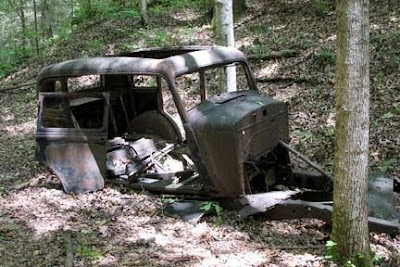 The Age of Adz album cover with artwork by Outsider artisit, Royal Robertson.
The Age of Adz album cover with artwork by Outsider artisit, Royal Robertson.Every blue moon, one is lucky enough to attend a concert with a sum more than its parts. You
leave with a feeling...a feeling of newness, of understanding, and with a connection that lingers for days, weeks, or if you are lucky, for a lifetime.
Sufjan Stevens has been quoted as saying that "music is a spiritual language" and he did his part to bring that thought to life at his Age of Adz concert in
Asheville, NC, Sunday night. I was thankful I had taken the time earlier to look up previous concert
setlists before arriving, noticing that he had played mostly new songs and they were the same songs in the same order for almost every show. So as I sat in the 2
nd row (thanks to my best sister, the ticket fairy), I thought to myself, "this is a man with a plan." And a plan
indeed it was.
Sufjan Stevens took us on a voyage, and the
Asheville crowd loved the ride. I could try to describe the sights and sounds, but that has probably been done plenty and my words would in no way describe how wonderful it was. It was great music, great effects, crazy

dancing, crazy hats, mesmerizing screen images, and a gifted performer baring his heart on a stage. It was an interactive and physical experience even if you never budged from your seat. It was an artist who traded the familiar and popular image of low keyed, softly sung guitar strummed songs for a busy, techno, synthesized, melodramatic performance that packed more bang to the heart than two hours of whispered secrets. And I am still asking myself, how on earth did he do that? A moment of enlightenment did come near the end when
Sufjan paused

and referred to a quote by Walt Whitman saying "Walt Whitman said we all contain multitudes. So we should
exhibit multitudes." You felt as though it was an apology combined with hope of an explanation and you could almost feel the audience sigh, "that's right."
Sufjan also
stopped in the middle of the concert to tell of his inspiration for Adz which came from the Outsider artist, Royal

Robertson. Royal was a mentally ill sign painter in Louisiana, who lost
everything to this illness, but like most Outsiders, his art was his constant. Royal's illness led him to be consumed with scorn for his ex-wife,
Adell, and this scorn led him to find his inspiration for his art.
Sufjan explained that in spite of his scorn,
Adell loved Royal and was at peace with him. This was a
"When I give, I give myself" Walt Whitman
man she had 12 children with... he was much more than an unemployed, mentally ill sign painter. It was evident from the way he spoke of her, that
Sufjan was very connected to
Adell. Maybe because there were multitudes to Royal and
Adell understood.
 Royal Robertson, the Louisiana Outsider artist who inspired The Age of Adz. He died in 1997.
Royal Robertson, the Louisiana Outsider artist who inspired The Age of Adz. He died in 1997.
Sufjan ended the set with his older, most famous song, Chicago, just as he had so beautifully begun the voyage with the older and popular, Seven Swans. After almost 10 minutes of hearty applause with the crowd on their feet, Sufjan came back and performed four of his old, bare-naked songs, strumming a guitar and bringing forth his soul-shattering falsetto. He left the stage, walking backwards, facing the crowd, placing his hand from his heart toward the audience over and over again. Like Whitman, who was transitional between transcendentalism and realism, Sufjan had just gone full circle and beautifully incorporated both spectrums of his work. At his other concerts this year, he has always done old songs at the encore, but usually only performing two or three songs and rarely four. I think he did four songs Sunday as a gift to Asheville because he was truly appreciative. Appreciative that we took the ride and we got it. We filed out of Thomas Wolfe Auditorium, somehow different, ready to exibit our multitudes.
























